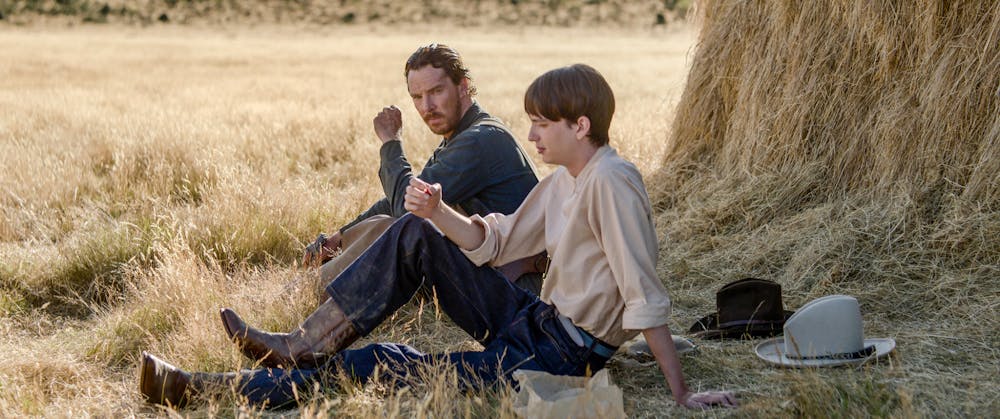The cinematic world does not make movies like “The Power of the Dog” anymore. Like many of its contemporaries, it is a decidedly aesthetic film, with boundless scenery and a respectable score. What sets director Jane Campion’s work apart is the film’s ability to string together a thoughtfully crafted series of events to tell a full-bodied story from beginning to end. Every action has a purpose; each piece of dialogue is delivered with an underlying aim. So when the ending of the film finally does arrive, instead of frustration, viewers are left satisfied. If they follow the signs, they will see what is coming. And if they don’t, more power goes to Campion — she certainly knows how to creep up on her audiences from behind.
Based on the book by Thomas Savage, “The Power of the Dog” is a western set in 1925 following the lives of two cattle ranchers, George and Phil Burbank. George (Jesse Plemons) is the softer and cleaner brother who handles the administrative side of the business. He finds love in widow Rose Gordon (Kirsten Dunst) and is mocked incessantly for the romance by his brother. Phil (Benedict Cumberbatch), by contrast, seems to be the embodiment of a standard tough cowboy: dirty, domineering and more than willing to castrate a bull by hand. But there are reasons for the steel front he puts up, and as the film plays out, we watch Phil unravel along with it.
The key to Phil’s unfolding can be found in perhaps the most intriguing character of Campion’s film: Rose’s son Peter (Kodi Smit-McPhee), who is studying to be a medical student. Phil first encounters Peter while eating at Rose’s restaurant. He pokes fun at him, choosing to ridicule the boy’s job as a waiter and burn the paper flower bouquets he creates to place on the tables he waits. Peter is odd, detached and surrounded by a strangely elegant air. He is about as unmasculine as rural Montana gets, which sets Phil on a mission to assert his dominance over the boy.
The entire film is characterized by a series of conflicts — although they are not your traditional cowboy-to-cowboy standoffs. Animosity has clearly defined Phil and George’s history. Phil is introduced to viewers as a decidedly broken man, while his brother appears relatively whole. Phil constantly tries to make George feel inferior. Another conflict lies in Rose and Phil’s relationship — they loathe each other. Phil can’t stand the fact that a drunken widow has latched on to his family, so he quickly takes to playing mind games with her. Rose, as a result, becomes deathly afraid of what Phil might do to her son. The defining conflict of the film is between Phil and Peter, who are what you’d call equal but opposite. Phil initially can’t stand the boy because of a secret they have in common (a secret he keeps close to his chest): Peter and Phil are both gay.
The film’s main source of tension comes from Phil’s anger. He appears to have bottled up a lot of pain throughout his life and is now taking that pain out on those around him, including George, Rose and Peter. But Phil’s emotional wall soon begins to crumble. He finds himself growing closer to Peter, partially because the boy reminds him of his late friend Bronco Henry, of whom he was uncharacteristically fond. But as they say, “You reap what you sow.” Ultimately, Phil’s actions come back to haunt him when, at the end of the film, Peter kills Phil for his mistreatment of Rose.
The moments of revelation in “The Power of the Dog” are quiet but well done, resulting from an accumulation of small inconsistencies that Campion drops throughout the film. Despite a demeanor that makes Phil appear to have never left Montana, it is mentioned at a dinner party that he actually went to Yale. And though Phil acts like he has few relationships he cares about, he drops Bronco Henry’s name several times. Parallels are even established between Phil and Peter right after they meet each other. Viewers are first shown a shot of Peter hula-hooping, directly followed by one of Phil mirroring the motion by spinning a table chair. Such details might be better caught on a second watch, as picking up on many of Campion’s subtleties requires effort on the part of the viewer.
In fact, the film is steeped in subtlety. Seemingly insignificant objects contribute to the film’s plot. From Peter’s comb to Rose’s gloves to Phil’s handkerchief, each object helps explain quite effortlessly why a closeness between Peter and Phil inevitably ensues throughout the film.
Cinematography doesn’t get much better than that in “The Power of the Dog.” The gray, rolling hills characterizing the entire film are vast and stunning, giving the rural American West a sense of boundlessness. They would normally make a viewer want to stop and click pause, but the film is cognizant of this beauty. It takes care to contrast the scope of the land with its small, distant characters, using several faraway shots. The music paired with such scenes is similarly stunning, consisting mainly of tense, orchestral accompaniments, a soft piano and a solemn guitar. Care is taken to avoid overlapping these voices with those of the characters — an incredibly smart move to showcase both score and actors alike.
The “Power of the Dog” is cast beautifully. Jesse Plemons is just mellow enough to play George, and Kirsten Dunst is just weathered enough to be a drunken widow. Kodi Smit-McPhee possesses all of the eerie grace integral to Peter’s character, and Benedict Cumberbatch’s undeniably-off Western accent somehow makes his character even stronger.
Although Campion’s film is incredibly well-rounded — as is evident in its 12 Academy Award nominations — its ending still stands as its high point. It is not drawn-out because it doesn’t need to be; after one last scene between Peter and Phil, Phil falls ill, and the film cuts to George picking out his brother’s coffin. Peter is left with the evidence. Viewers never see Peter kill Phil, but they know he did it. Campion lays the foundation for her last few scenes with one of the film’s very first lines. “And what kind of man would I be,” Peter asks, “if I did not help my mother?”

Rya is an Arts & Culture editor from Albany, NY. She is a senior studying English and Literary Arts, and her favorite TV show is Breaking Bad.





